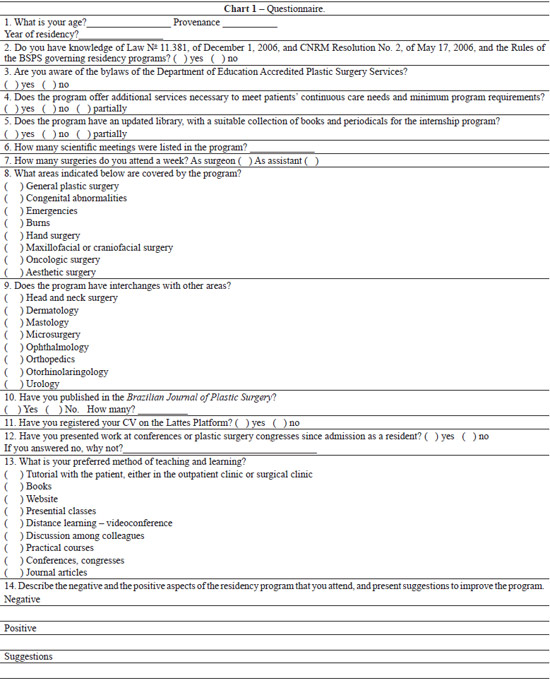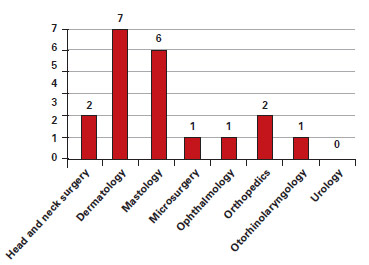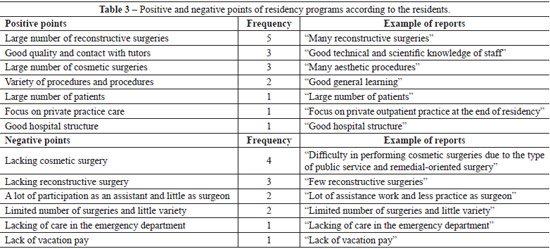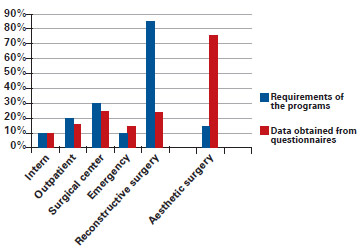ABSTRACT
INTRODUCTION: The residency period is an important step in the medical training of plastic surgeons in Brazil. However, there are few qualitative studies about the existing residency programs. Thus, the aim of this study was to conduct a qualitative research of the medical residency programs of the accredited services of the Brazilian Society of Plastic Surgery in Distrito Federal.
METHODS: This cross-sectional study was performed through individual structured questionnaires, which were self-administered by residents training in the accredited services of Distrito Federal, in 2012.
RESULTS: Eighteen residents (age range, 25-52 years; 13 [72.2%] men and 5 [27.8%] women) agreed to participate. Of them, 61.1% reported that the hospital had complementary services necessary to meet patients' continuous care and the minimum requirements of the program, 66.7% thought that the bibliographic archive was only partially adequate or inadequate, and 72.2% reported to participate in 2 or more hours of weekly scientific meetings. Participation in 5 to 10 surgeries per week was reported by 88.8% of participants. Most residents said that they participate for up to 4 hours/week as a surgeon and 11-20 hours/week as an assistant. Most (66.7%) of residents had made presentations at scientific meetings, and 72.2% had no articles published in the Brazilian Journal of Plastic Surgery. With respect to the workload of the residency program, 80% were assigned to outpatient, infirmary, and surgical center activities, and 20% were assigned to theoretical activities. Among the suggestions mentioned to improve the medical residency programs were the need to increase the scope and the interchange between services, as well as the encouragement of scientific research output.
CONCLUSIONS: The perception of plastic surgery residents in the accredited services of Distrito Federal, about the curriculum, program structure and teaching performance, was positive. The negative aspects mentioned were the range and distribution of the curriculum, lack of emergency care, inadequate training in reconstructive procedures, and compact training in other areas, as well as an unsatisfactory bibliographic archive and lack of incentive for researchers. Among the suggestions especially mentioned for the improvement of the medical residency programs were the need to increase the scope and the exchange between services, as well as the encouragement of scientific research output.
Keywords:
Plastic surgery. Teaching. Education. Education, medical. Internship and residency.
RESUMO
INTRODUÇÃO: A residência médica é um passo importante no treinamento dos médicos residentes de Cirurgia Plástica no Brasil; entretanto, são poucos os estudos que avaliam os programas de residência sob o ponto de vista qualitativo. Assim, este artigo objetiva realizar pesquisa qualitativa dos programas de residência médica dos serviços credenciados da Sociedade Brasileira de Cirurgia Plástica no Distrito Federal.
MÉTODO: Foi realizado estudo transversal, com a aplicação de questionário individual estruturado, autoaplicado aos residentes em treinamento nos serviços credenciados do Distrito Federal, no ano de 2012.
RESULTADOS: Dezoito médicos residentes, com idade entre 25 anos e 52 anos, 13 (72,2%) homens e 5 (27,8%) mulheres, concordaram em participar da pesquisa. Desses, 61,1% relataram que o hospital dispunha de serviços complementares necessários ao atendimento ininterrupto dos pacientes e aos requisitos mínimos do programa, 66,7% consideraram que o acervo bibliográfico era parcialmente adequado ou inadequado, e 72,2% referiram ter 2 ou mais horas de reuniões científicas semanais. A participação em 5 a 10 cirurgias por semana foi reportada por 88,8% dos participantes; a maioria dos residentes afirmou participar de até 4 horas/semana como cirurgião e de 11 a 20 horas/semana como auxiliar. A maioria (66,7%) dos residentes já havia realizado apresentações em eventos científicos e 72,2% não tinham artigos publicados na Revista Brasileira de Cirurgia Plástica. Com relação à carga horária do programa de residência, 80% eram destinados a atividades em ambulatório, enfermaria e centro cirúrgico e 20%, a atividades teóricas. Dentre as sugestões de melhoria dos programas de residência médica, foram apontados, principalmente, a necessidade de aumentar a abrangência e o intercâmbio entre os serviços e o incentivo à produção científica.
CONCLUSÕES: A percepção dos residentes em cirurgia plástica dos serviços credenciados do Distrito Federal foi positiva no que se refere a grade curricular do programa, estrutura para atendimento e desempenho da preceptoria. Quanto aos pontos negativos, foram apontados abrangência e distribuição da grade curricular, falta de atendimento de emergência, menor treinamento em procedimentos de natureza reparadora e reduzido em estágios de outras áreas, além de acervo bibliográfico insatisfatório e pouco incentivo à pesquisa. Dentre as sugestões de melhoria dos programas de residência médica, foram apontados, principalmente, a necessidade de aumentar a abrangência e o intercâmbio entre os serviços e o incentivo à produção científica.
Palavras-chave:
Cirurgia plástica. Ensino. Educação. Educação médica. Internato e residência.















